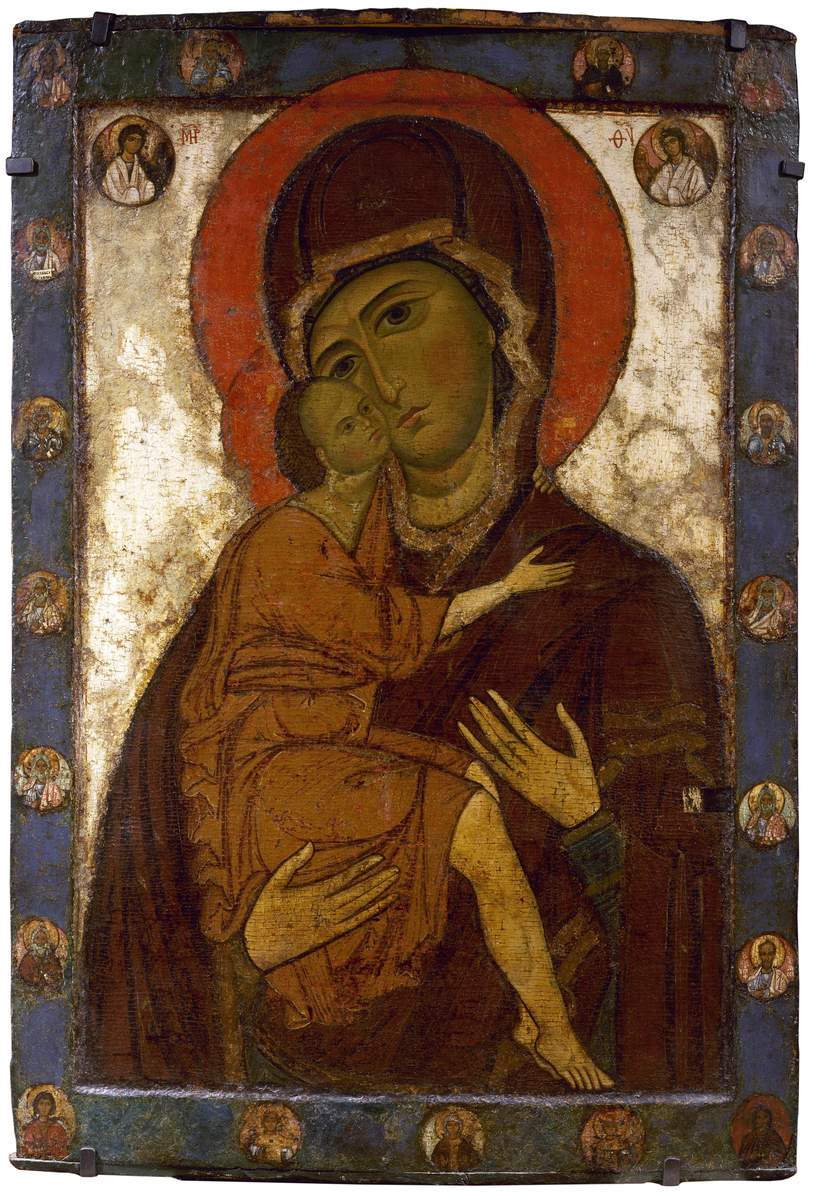


Икона принадлежит к числу наиболее известных среди немногих сохранившихся образов Богоматери периода Древней Руси. Полуфигура Богоматери монументальна и величественна, огромные глаза полны скорби, лик склонен к прильнувшему к ней сыну. Ее лаконичный, графически четкий силуэт уподоблен силуэту храма, очертание головы, покрытой темно-вишневым мафорием, напоминает купол. Изображение тела Христа Эммануила не выступает за пределы контура фигуры Богоматери, щека Младенца прикасается к щеке Матери, их нимбы слились. Они едины и нераздельны. Христос сидит на правой руке Богородицы. Ей поклоняются ангелы с покровенными руками, помещенные в круглых медальонах в верхних углах ковчега. Движения рук Богородицы образуют крест. Крестообразная ритмика свойственна также жестам и движениям Христа Эммануила. Специфической особенностью иконографии Эммануила является подчеркнуто крупное его изображение по сравнению с Богоматерью. Младенец облачен в короткую одежду охряного цвета, оставляющую открытыми ноги и руки. Эта обнаженная непорочная плоть младенца Христа отчетливо выявляет значение его образа как евхаристической жертвы, жертвенного агнца. Таким образом, центральное изображение интерпретируется как образ Богоматери-Церкви, храма Божьего, в котором воплощен Бог Слово, образ искупительной жертвы, извечно приносимой и приносящей. Русский музей. От иконы до современности. СПб. 2015. С. 40.
Икона происходит из Белозерья (Вологодская обл.). Композиционный тип иконы сложился в XI веке в Византии, где он назывался «Елеуса» (греч. — Милующая). Подобного рода изображения были широко распространены в средневековом искусстве всех европейских стран. Богоматерь изображается с младенцем Христом, прижавшимся щекой к ее лицу. Русское наименование «Умиление» наиболее точно и выразительно передает момент задушевного общения матери, провидящей будущие страдания Иисуса, с сыном. Большой непосредственностью и яркостью образов отличаются поясные изображения архангелов в круглых медальонах в верхних углах средника, пророков и святых жен — в 19 медальонах на полях. У таких икон люди искали заступничества и покровительства.

The icon is based on the compositional scene of Tenderness (Greek: Eleusa), depicting the Virgin and Child with their cheeks pressed together. This particular work is one of the most famous surviving images of the Theotokos from the Old Russian period. The halflength figure of the Virgin Mary is monumental and majestic. Her enormous eyes are full of sorrow, while her countenance is turned towards Jesus. The laconic and distinct outline of the Mother of God is likened to the silhouette of a church, while the head in the dark cherry-red veil recalls a cupola.
The body of Christ Emmanuel does not extend beyond the bounds of the figure of the Virgin. The cheek of the Child brushes against His mother’s face and their haloes merge, symbolising their unbreakable unity. Christ sits on the right hand of Mary, who is worshipped by the angels with covered arms in the round medallions in the top corners. The movement of the Virgin’s hands forms a cross, while the gestures of Christ are also crossshaped.
The large image of the Infant in comparison to the Mother of God is a specific feature of the iconography of Christ Emmanuel. Jesus is dressed in a short, ochre-coloured tunic, revealing the immaculate flesh of the Child and conjuring up associations with the Eucharist sacrifice or sacrificial lamb. The entire image thus represents the incarnation of the Word inside the church of God and Jesus’ eternal, redemptive sacrifice. Russian Museum: From Icons to the Modern Times. Palace Editions, St Petersburg, 2015. P. 42.



